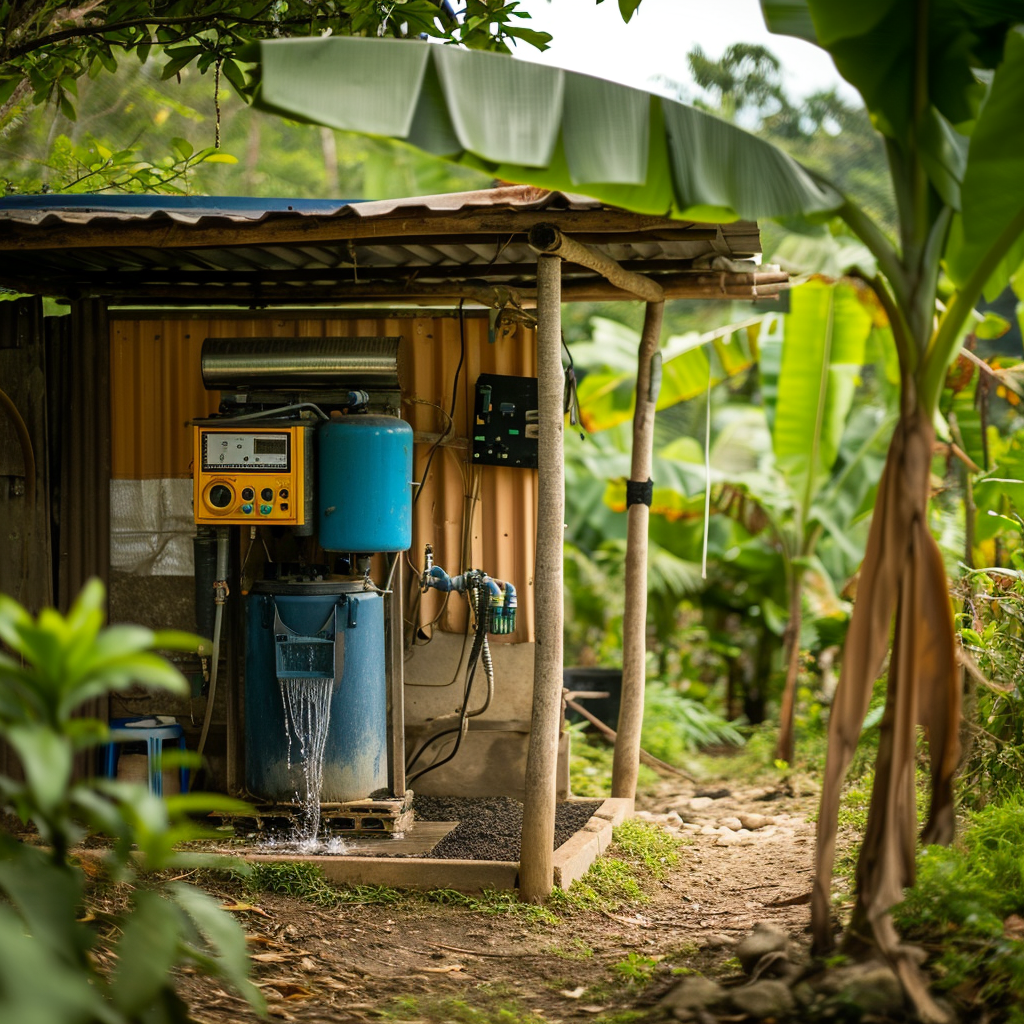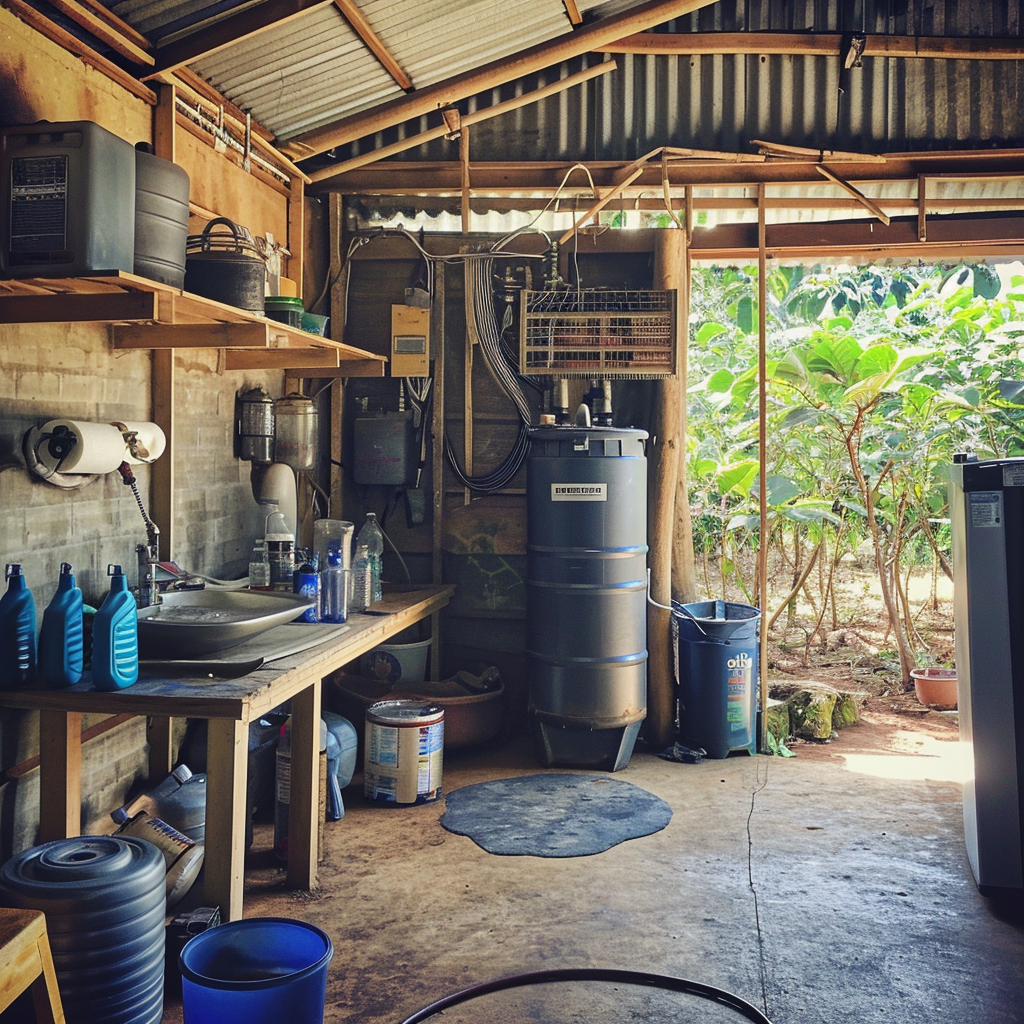So, you’ve decided to live off the grid. No more relying on the city’s water supply or electricity. It’s a liberating feeling, isn’t it? But now you’re faced with the challenge of making your gravity fed system more efficient. What if I told you there’s a way to add a pump to your system? Yes, you heard that right. In this article “How to Add a Pump to a Gravity Fed System“, we’ll discuss how you can do just that.
Adding a pump to a gravity fed system might seem like a daunting task at first, but trust me, it’s not as complicated as it sounds. By introducing a pump into your system, you can increase water pressure and flow, making it easier to distribute water throughout your off-grid home. But how exactly does this work? Well, you see, the pump is strategically placed in your system to draw water from a storage tank at a lower level and deliver it to another tank or directly to your taps. Pretty cool, right?
Now, you might be wondering how to go about adding a pump to your gravity fed system. Don’t worry, we’ve got you covered. In our comprehensive guide, we’ll walk you through the step-by-step process of selecting the right pump, determining its placement, and connecting it to your existing system. We’ll even provide you with some useful tips and troubleshooting advice along the way. So, if you’re ready to take your off-grid living to the next level, keep reading to learn more about how to add a pump to a gravity fed system.
Living off the grid often requires finding alternative solutions for basic needs such as water supply. Gravity fed systems are a popular choice for off-grid living as they rely on the natural force of gravity to supply water to homes and other buildings. However, these systems have limitations, including limited pressure and flow, distance and elevation challenges, and inconsistent water supply. In this article, we will explore how to overcome these challenges by adding a pump to a gravity fed system.
Understanding Gravity Fed Systems
What is a gravity fed system?
A gravity fed system is a water supply system that relies on gravity to move water from a high point to a lower point without the need for mechanical pumps. The system consists of a water source located at a higher elevation, typically a well or a storage tank, and pipes or channels that carry the water to the desired location.
How does a gravity fed system work?
In a gravity fed system, water naturally flows from a higher elevation to a lower elevation due to the force of gravity. The water source, located at a higher elevation, provides the necessary pressure for the water to flow through the pipes and reach the desired location. This process eliminates the need for additional power sources or pumps.
Benefits of a gravity fed system
Gravity fed systems have several advantages for off-grid living. Firstly, they are energy-efficient and environmentally friendly as they do not require electricity or fuel to operate. They also provide a continuous water supply without the need for external power sources. Additionally, gravity fed systems are relatively low maintenance compared to pump-operated systems, as there are fewer mechanical components that can break or malfunction.

Challenges of a Gravity Fed System
Although gravity fed systems offer numerous benefits, they also come with their own set of challenges.
Limited pressure and flow
Due to their reliance on gravity, gravity fed systems have natural limitations on water pressure and flow rate. The pressure and flow are determined by the vertical distance between the water source and the point of use. If the elevation difference is minimal, the system may not provide adequate pressure or flow to meet the demands of the household.
Overcoming distance and elevation limitations
Another challenge of gravity fed systems is the limitation on distance and elevation. If the water source is located at a significant distance or a much higher elevation than the point of use, the system may not be able to deliver water effectively. This can result in reduced pressure, flow, or even no water at all reaching the desired location.
Issues with inconsistent water supply
Gravity fed systems are also susceptible to interruptions in the water supply, especially during periods of drought or when relying on rainwater collection. Without a steady water source, the system may not be able to provide a consistent water supply to meet daily needs.
Introduction to Pumps
What is a pump?
A pump is a mechanical device designed to move fluids, such as water, from one location to another. It uses mechanical force, such as a motor or an engine, to create pressure and push the fluid through a system of pipes or channels.
Types of pumps available
There are several types of pumps available for various applications. In the context of adding a pump to a gravity fed system, the two most common types are centrifugal pumps and submersible pumps. Centrifugal pumps are typically used for boosting water pressure in gravity fed systems, while submersible pumps are suitable for retrieving water from a well or underground source.
Functions and components of a pump
A pump has several essential functions and components that enable it to move water effectively. The impeller, a rotating component, is responsible for drawing water into the pump and then pushing it through the system. The motor or engine provides the necessary power to drive the impeller. Other parts, such as valves, pipes, and seals, work together to ensure the pump operates efficiently and effectively.
Compatibility of Pumps with Gravity Fed Systems
Can you add a pump to a gravity fed system?
Yes, it is possible to add a pump to a gravity fed system. In fact, adding a pump can help overcome the limitations of gravity fed systems, such as limited pressure and flow. By boosting the pressure, a pump can increase the functionality and reliability of a gravity fed system.
Factors to consider for compatibility
When adding a pump to a gravity fed system, several factors need to be considered to ensure compatibility. Firstly, the pump must be suitable for the specific application. For example, if the system requires boosting pressure, a centrifugal pump will be more suitable. On the other hand, if retrieving water from a well, a submersible pump would be the better choice.
Additionally, the pump’s flow rate and pressure capabilities should match the demands of the system. It is crucial to calculate the required flow rate and pressure based on the intended usage, such as the number of fixtures in the house or the irrigation needs of a garden.
Determining the right pump for your system
To determine the right pump for your gravity fed system, it is important to consider the specific requirements of your system. Consultation with a professional or a pump specialist can be helpful in selecting the appropriate pump based on the system’s needs. They can assess the elevation, distance, and other factors that may impact the pump’s performance and recommend the best options.
Preparing to Add a Pump
Evaluating your system’s needs
Before adding a pump to your gravity fed system, it is essential to evaluate your system’s needs. Consider the water demands of your household or property, including the number of fixtures, appliances, and irrigation systems that rely on the water supply.
Additionally, assess any limitations or challenges your gravity fed system currently faces, such as low water pressure or flow. Understanding these needs and challenges will help determine the type and capacity of the pump required.
Calculating required pressure and flow rate
To ensure the pump meets your system’s needs, it is important to calculate the required pressure and flow rate. The pressure requirement will depend on the fixtures or appliances that require a specific pressure to operate effectively. The flow rate will be determined by the number of fixtures and the simultaneous usage demand.
Consult a pump specialist or refer to the manufacturer’s specifications to determine the appropriate pressure and flow rate for your system.
Sizing and selecting the pump
Once the required pressure and flow rate are determined, it is time to size and select the pump. Consider the head pressure, which is the difference in elevation between the water source and the point of use when sizing the pump. The head pressure will affect the pump’s performance and efficiency.
Again, consulting with a pump specialist or referring to manufacturer guidelines can help in selecting the right pump size and capacity for your system.
Installation Process
Locating the ideal pump installation point
When installing a pump in a gravity fed system, it is important to find the ideal pump installation point. The installation point should be close to the water source and at a suitable elevation to optimize the pump’s performance. Additionally, ensure the installation point is easily accessible for maintenance and repairs.
Preparing the plumbing for the pump
Before installing the pump, the plumbing system needs to be prepared. This involves ensuring the pipes are clean, free from debris, and properly connected. Any necessary repairs or modifications should be made prior to installation.
Connecting the pump to the existing system
Once the plumbing is prepared, the pump can be connected to the existing gravity fed system. This involves connecting the inlet and outlet pipes of the pump to the corresponding pipes in the system. Ensure the connections are secure and watertight to prevent any leaks.
Adding a Pump Controller
What is a pump controller?
A pump controller is a device that helps regulate and control the operation of a pump. It monitors various parameters such as water pressure and flow rate and adjusts the pump’s performance accordingly. A pump controller can also provide additional features such as protection against dry running or overload.
The role and benefits of a pump controller
The primary role of a pump controller is to optimize the pump’s operation and protect it from potential damage. By monitoring pressure and flow rate, a pump controller can ensure the pump operates within the desired range, preventing issues such as excessive pressure or insufficient flow.
Pump controllers also offer convenience and flexibility. They can be programmed to start or stop the pump based on specific time schedules or demand. This allows for efficient water management and prevents the pump from running continuously when not needed.
Installing and setting up a pump controller
To install a pump controller, follow the manufacturer’s instructions, which may vary depending on the specific model. Typically, it involves connecting the pump controller to the pump and the power source. Once installed, the pump controller can be set up and programmed according to the system’s needs.
Testing and Adjusting the System
Checking for leaks and proper operation
After the pump and pump controller are installed, it is important to test the system for any leaks or issues. Turn on the pump and check for any signs of leakage in the plumbing connections and components. Additionally, ensure the pump is operating smoothly and there are no unusual noises or vibrations.
Adjusting pump settings for optimal performance
Once the system is operational, it may be necessary to adjust the pump settings for optimal performance. This can include adjusting the pressure or flow rate to meet the specific needs of the household or property. Consult the manufacturer’s guidelines or seek professional assistance to ensure the settings are adjusted correctly.
Monitoring and maintaining the system
Once the system is up and running, it is important to regularly monitor and maintain the pump and pump controller. This includes checking for any signs of wear or damage, cleaning or replacing filters, and lubricating any moving parts. Regular maintenance can extend the lifespan of the pump and ensure it continues to operate efficiently.

Troubleshooting Common Issues
Low water pressure or flow
If you experience low water pressure or flow after adding a pump to your gravity fed system, several factors may be at play. Check for any clogs or obstructions in the pipes or filters and clean or replace them as necessary. Additionally, ensure the pump is functioning properly and that the pressure and flow settings are adjusted correctly.
Pump cycling on and off
If the pump continuously cycles on and off, it may indicate a problem with the pump controller or pressure tank. Check for any issues with the electrical connections or pressure tank’s air bladder. If necessary, consult a pump specialist to diagnose and resolve the issue.
Dealing with power outages
During power outages, a pump in a gravity fed system will not operate as it relies on electricity to function. To mitigate this issue, consider installing a backup power source, such as a generator or a battery backup system, to ensure continuous water supply during power outages.
Conclusion
Adding a pump to a gravity fed system can significantly enhance its functionality and overcome the limitations of limited pressure and flow. By understanding your system’s needs, selecting the right pump and pump controller, and performing proper installation and maintenance, you can successfully integrate a pump into your gravity fed system. This not only ensures a reliable water supply but also provides the flexibility to meet the demands of off-grid living.




